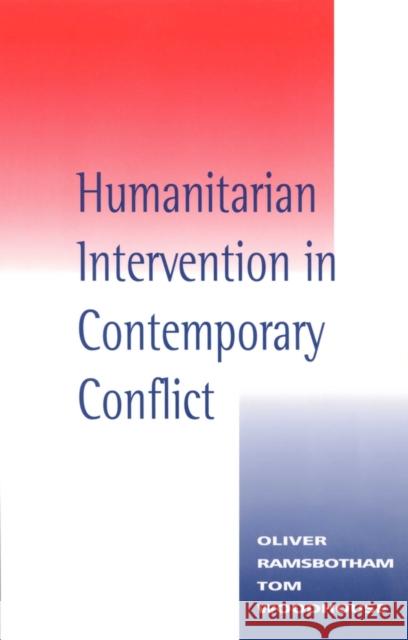Humanitarian Intervention in Contemporary Conflict » książka



Humanitarian Intervention in Contemporary Conflict
ISBN-13: 9780745615110 / Angielski / Miękka / 1996 / 288 str.
Humanitarian Intervention in Contemporary Conflict
ISBN-13: 9780745615110 / Angielski / Miękka / 1996 / 288 str.
(netto: 92,29 VAT: 5%)
Najniższa cena z 30 dni: 96,51
ok. 30 dni roboczych
Bez gwarancji dostawy przed świętami
Darmowa dostawa!
This is the first comprehensive account of humanitarian intervention in contemporary conflict.
Wydanie ilustrowane
"Insightful, informed, imaginative and creatively bridging the gap between theory and policy analysis, this book is essential reading. The authors provide a definitive treatment of what is arguably the most salient topic in international relations today." Professor Charles Kegley, University of South Carolina
"A challenging and imaginative reconceptualization of the subject, helping to clarify the hard choices facing the international community when it tries to follow its conscience." Lawrence Freedman, King′s College, London
"Well–researched and well–documented, this book should be applauded and welcomed by both academics and practitioners." Juergen Dedring, United Nations, New York
"A remarkable achievement. The best available account of the ′classic′ position on humanitarian intervention and a good case for widening it. This is a book that will last." Chris Brown, Southampton University
"This timely addition to the literature of international law and relations provides a comprehensive, sorely needed review of the problematic concept and policy of humanitarian intervention. Although technical in portions, this compact work remains accessible and readable. It has no rival; it serves as an excellent textbook and indispensable guide for the general public, as well as for professional and academic audiences, eager to sort through the confusion of humanitarian intervention." Choice
"Offer[s] a brilliant insight into the concept of humanitarian intervention and make[s] an attempt at its reconceptualization." Africa World Review
"Contain[s] sufficient knowledge about past failures to draw accurate and useful lessons for future interventions." Journal of International Affairs
"This is a rewarding study for anybody looking at dilemmas in peace–keeping, humanitarian operations or other forms of humanitarian intervention in the 1990s." Journal of Peace Research
"One of the strengths of Humanitarian Intervention in Contemporary Conflict, lies in the treatment of international intervention. Their assessments will be informative to most undergraduate students about the International Committee of the Red Cross and Red Crescent Movement and other actors and their conceptions of humanitarianism, neutrality and impartially ... a useful addition that furthers our understanding of action in internationalised internal conflicts after the cold war." Survival
"[A] timely book ... insightful [with] direct relevance to both practitioners and scholars of humanitarian intervention ... Easily accessible and generally a highly useful source of knowledge for students of humanitarian intervention, the well–informed conceptual framework makes it a valuable contribution to the academic field in general." International Peacekeeping
"The book, which is rich in detail and, at the same time, manages to explain the realities underlying international humanitarian intervention, ends with a conclusion which will surely provide food for thought in the forthcoming years ... the ten diagrams, twenty five boxes and ′suggested reading′ in the different chapters make it very accessible for students specializing in these matters, as well as for academics and practitioners." International Relations
Preface.
Part I: The Classical Debate: Forcible Self–Help by States to Protect Human Rights: .
Introduction.
1. Humanitarianism, Human Rights and the International Community.
2. Forcible Self–Help in Defence of Human Rights: 1945–1990.
Part II: Reconceptualization: Humanitarian Intervention in Contemporary Conflict: .
Introduction.
3. Contexts.
4. Options.
5. Controversies.
Part III: Cases: .
6. Humanitarian Intervention in Bosnia.
7. Humanitarian Intervention in Somalia.
Conclusion.
Epilogue: Framework Principles for Humanitarian Intervention.
Appendix 1: United Nations Peacekeeping and Observer Missions Operating 1991–4.
Appendix 2: Other Acronyms.
References.
Index.
This timely book is a wide–ranging assessment of the international response to devastating contemporary conflicts, such as those in Bosnia, Somalia and Rwanda. As such, it is the first comprehensive account and examination of humanitarian intervention in the post–cold war period.
After a thorough survey of the traditional debates, the authors concentrate on an analysis of contemporary conflict, using illustrations from a range of post–cold war examples. Various options including non–intervention, non–forcible peacekeeping, and forcible humanitarian intervention are illustrated and discussed, with profiles of the most destructive contemporary conflicts and the responses to them by the international community. The roles of governments, UN agencies, the Red Cross and non–governmental organizations are carefully examined. From this material, the authors argue for a reconceptualization of humanitarian intervention and develop principles which, they argue, should govern all of its uses. The book ends with detailed accounts of Bosnia and Somalia.
In broadening and updating the theory of humanitarian intervention, this book balances clear explanation with detailed examples. It contains recommended further reading, diagrams and tables, and a full bibliography of references making it an ideal introduction for students studying international relations, international conflict and conflict resolution.
It will also be of interest to those governments, UN agencies, the Red Cross and non–governmental organizations concerned to develop a more effective response to humanitarian crisis.
1997-2025 DolnySlask.com Agencja Internetowa
KrainaKsiazek.PL - Księgarnia Internetowa









